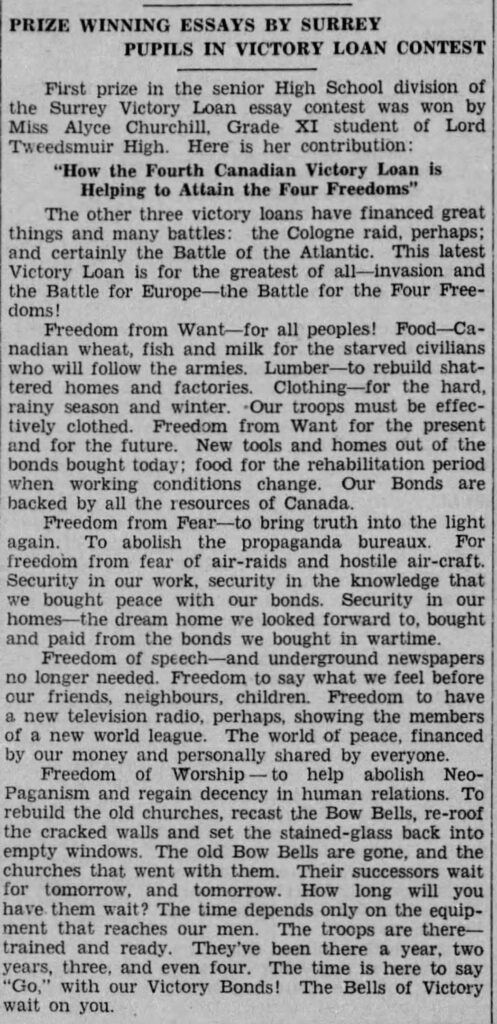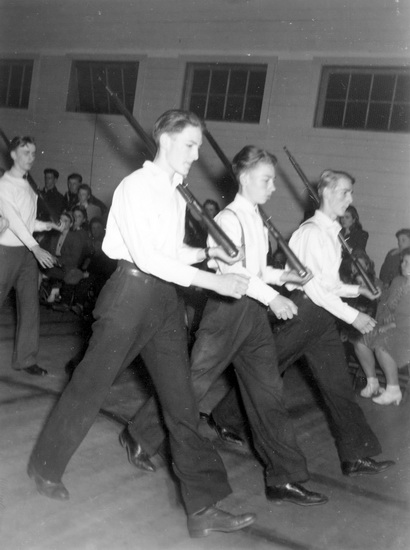In 1940 it was made a requirement for all students and teachers to assemble weekly to salute the flag and sing the national anthem. A student reporter described the experience at Lord Tweedsmuir, commenting that when singing God Save the King what they lacked in volume they “didn’t lack in spirit.” It is clear that this was enforced in Surrey schools, which is evident from the controversy about certain students not participating, and the school board deciding to take action against the families. In the high schools it was reported that students “of alien descent” did not attend these “patriotic exercises” by coming to school late, or not attending at all, which the board looked to rectify.1
The curriculum of schools was also altered, including the Social Studies Curriculum to include the causes of WWII, the Physical Education Curriculum to include compulsory cadet training, and the Industrial Arts curriculum to train student to be prepared for wartime industries. Not all school districts followed these reforms, with Industrial Arts shops only being built in 9% of the districts in BC. In Surrey there is evidence of the high schools following a curriculum that supported the war effort. For instance, Lord Tweedsmuir established a class on war industries for senior girls so that once graduating they could help “as the boys go off to war.” They were showcased at the school’s carnival working “with a forge and anvil, hammering out a cold chisel.”2
At Queen Elizabeth High School, a Victory Bond Essay contest was turned into a mandatory assignment for all students as part of their grade for their English class. The Queen Elizabeth Grade 12 winners’ essay argued that Victory Bonds were essential because “Canadians are faced with the alternative of fighting to preserve their hard fought political and social gains or submitting to dictatorship and subsequent slavery.” High school students were also shown films about the war, including the importance of oil, war tools, and Canadian soldiers who were overseas.3


Cadet training became mandatory for high school boys, grade nine and up in order to “foster civilian morale” and to help Canadian defense. Even before this became mandatory Surrey High School established the Cadet Corps as a club, who were to learn about “map reading, signaling, air raid precaution and drill formation” as well as some members learning first-aid, or band. A rifle range was built for them, so that they could practice shooting. This same range was also then opened to the public and was used in a spring carnival, complete with Hitler targets for participants to shoot at.4
“How many of you would like to take a crack at Hitler? Of course, you all would. Well you’ll be given that opportunity at the rifle range where shooting at Hitler targets will be in progress. Fine prizes of silver spoons, cups and admissions tickets to the fall fair will be shot for. Don’t fail to “drill” Hitler right smack between the eyes.”
“Carnival of Fun Slated for Sat. on Fair Grounds.” The Surrey Leader (Surrey, BC, Canada), June 12, 1940. Accessed through Surrey Archives.
Later all three schools had Cadet Corps, and although not mandatory, girls’ divisions of Cadet Corps were established in certain years. This was not considered to be as serious as the male cadets and was sometimes stylized as “Cadettes.” Cadette training tended to focus on drills or first aid. Some female cadets in Surrey were permitted to carry and shoot rifles. At Semiahmoo female cadets “learned the elements of military marching and commands.” A Student Reporter at Lord Tweedsmuir commented that some of the boys were concerned about the girls doing rifle drills, “but although one girl carried hers upside-down, they don’t do so badly.”5
All Cadets had to pass yearly inspections, and in Surrey this was often turned into an event that the public was welcome to attend. Outside of the inspections the high schools often showcased cadet drills, such as through an athletics display. The Squadron Leader and director for BC Air Cadets stressed the importance of compliance in cadets, explaining “If you can get these boys to obey an order because they want to, something more than ordinary discipline has been accomplished. Canada is going to need these young men who have got a sense of what they owe to their country.” In her thesis, Emilie Montgomery reported that those interviewed who had participated in cadets did not typically take it seriously, with many boys treating it like a game and feeling like they were “playing at soldiers.” Another, who joined the Navy, found that cadets did nothing to prepare him for the experience.6

At both Semiahmoo and Lord Tweedsmuir, the sense of patriotism even extended to their yearbooks. The first Semiahmoo High School annual was created in 1941 and the students decided to title it “The Torch” inspired by the torch that was being prepared at the time for Winston Churchill “as a sign of Canada’s determination to fight in World War II.” The 1942 Lord Tweedsmuir Yearbook was dedicated to the schools former students and teachers who joined the armed forces “to help preserve our way of life.”7
Next Page → Clubs and Fundraising During the War
References
- “Among the Students.” The Surrey Leader (Surrey, BC, Canada), November 13, 1940. Accessed through Surrey Archives.; “Name of Cloverdale High School Changed.” The Surrey Leader (Surrey, BC, Canada), October 16, 1940. Accessed through Surrey Archives.; “Non-Saluters of Flag to be Dealt with Here.” The Surrey Leader (Surrey, BC, Canada), December 4, 1940. Accessed through Surrey Archives.; Raptis. “My Job Was to Teach,” 452. ↩︎
- Emilie L. Montgomery “‘The War Was a Very Vivid Part of My Life’: British Columbia School Children and the Second World War,” 1991. https://search.ebscohost.com/login.aspx?direct=true&AuthType=sso&db=ddu&AN=6709D90C094B80FA&site=eds-live., 51-52.; Raptis. “My Job Was to Teach,” 452.; “Successful Carnival Held at Lord Tweedsmuir High.” The Surrey Leader (Surrey, BC, Canada), April 21, 1943. Accessed through Surrey Archives.; The Lord Tweedsmuir Reporter. “Among the Students.” The Surrey Leader (Surrey, BC, Canada), December 2, 1942. Accessed through Surrey Archives. ↩︎
- Marguerite Bennetton. “Semiahmoo High School.” The Surrey Leader (Surrey, BC, Canada), December 30, 1923. Accessed through Surrey Archives.; May Pearson, “Among the Students.” The Surrey Leader (Surrey, BC, Canada), November 11, 1942. Accessed through Surrey Archives.; “Queen Elizabeth High.” The Surrey Leader (Surrey, BC, Canada), June 4, 1941. Accessed through Surrey Archives.; “Winning Essay on Victory Bonds from Queen Elizabeth High School.” The Surrey Leader (Surrey, BC, Canada), June 25, 1941. Accessed through Surrey Archives. ↩︎
- “Cadet Training Plan to be Revived in B.C.” The Surrey Leader (Surrey, BC, Canada), July 31, 1940. Accessed through Surrey Archives.; “Carnival of Fun Slated for Sat. on Fair Grounds.” The Surrey Leader (Surrey, BC, Canada), June 12, 1940. Accessed through Surrey Archives.; “Surrey High Pioneers Cadets in Rural Areas.” The Surrey Leader (Surrey, BC, Canada), June 12, 1940. Accessed through Surrey Archives.; The School Reporter. “Among the Students.” The Surrey Leader (Surrey, BC, Canada), February 21, 1940. Accessed through Surrey Archives.; The School Reporter. “Among the Students.” The Surrey Leader (Surrey, BC, Canada), March 13, 1940. Accessed through Surrey Archives. ↩︎
- Lord Tweedsmuir High School, The Salute (Surrey, BC: 1942), Courtesy of the Lord Tweedsmuir Alumni Association.; Montgomery “The War Was a Very Vivid Part of My Life,” 79, 87-88.; “Semiahmoo High School.” The Surrey Leader (Surrey, BC, Canada), November 5, 1940. Accessed through Surrey Archives.; The Student Reporter. “Among the Students.” The Surrey Leader (Surrey, BC, Canada), April 2, 1941. Accessed through Surrey Archives.; The L.T.H.S. Reporter. “Among the Students.” The Surrey Leader (Surrey, BC, Canada), April 22, 1942. Accessed through Surrey Archives.; The Student Reporter. “Semiahmoo High.” The Surrey Leader (Surrey, BC, Canada), February 16, 1942. Accessed through Surrey Archives. ↩︎
- Annuals, 1944-1945, F623-0-2, Baker family collection, Courtesy of Surrey Archives, Surrey, BC, Canada.; “High School Gym Display Monday Thrills Audience.” The Surrey Leader (Surrey, BC, Canada), December 17, 1941. Accessed through Surrey Archives.; “Lord Tweedsmuir Cadets Inspected by Maj. Critchley.” The Surrey Leader (Surrey, BC, Canada), May 21, 1941. Accessed through Surrey Archives.; Montgomery “The War Was a Very Vivid Part of My Life,” 79, 87-88.; “Squadron Leader Symonds Addresses Surrey Junior C.C.” The Surrey Leader (Surrey, BC, Canada), January 26, 1944. Accessed through Surrey Archives. ↩︎
- 190.1.18 – Untitled, 1980-1981, F125-0-24-1-14, Box 1, File 18, Historical Manuscripts Collection: Education: Schools and Teachers, Courtesy of Surrey Archives, Surrey, BC, Canada.; Lord Tweedsmuir High School, The Salute (Surrey, BC: 1942), Courtesy of the Lord Tweedsmuir Alumni Association. ↩︎